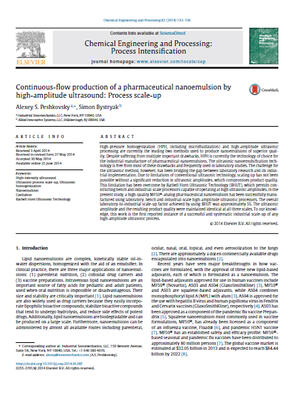Alexey S. Peshkovsky, Simon Bystryak, Chemical Engineering and Processing: Process Intensification, Volume 82, August 2014, Pages 132-136.

High-pressure homogenization (HPH, including microfluidization) and high-amplitude ultrasonic processing are currently the leading two methods used to produce nanoemulsions of superior quality. Despite suffering from multiple important drawbacks, HPH is currently the technology of choice for the industrial manufacture of pharmaceutical nanoemulsions. The ultrasonic nanoemulsification technology is free from most of these drawbacks and frequently used in laboratory studies. The challenge for the ultrasonic method, however, has been bridging the gap between laboratory research and its industrial implementation. Due to limitations of conventional ultrasonic technology, scaling up has not been possible without a significant reduction in ultrasonic amplitudes, which compromises product quality. This limitation has been overcome by Barbell Horn Ultrasonic Technology (BHUT), which permits constructing bench and industrial-scale processors capable of operating at high ultrasonic amplitudes. In the present study, a high-quality MF59®-analog pharmaceutical nanoemulsion has been successfully manufactured using laboratory, bench and industrial-scale high-amplitude ultrasonic processors. The overall laboratory-to-industrial scale-up factor achieved by using BHUT was approximately 55. The ultrasonic amplitude and the resulting product quality were maintained identical at all three scales. To our knowledge, this work is the first reported instance of a successful and systematic industrial scale-up of any high-amplitude ultrasonic process.
Industrial Sonomechanics is a R&D, equipment design and process consulting firm, specializing in high-power ultrasonic technology for liquid treatment. Our mission is to help businesses implement their ultrasound-assisted processes on lab, pilot and industrial scales.
[fa icon="phone"] 786-233-9255
[fa icon="envelope"] contact@sonomechanics.com
[fa icon="home"] 7440 SW 50th Terrace #110, Miami FL 33155